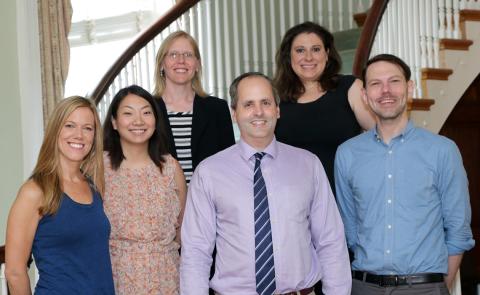PRAT Fellows Find Success Through Support

Photo: Bill Branson
Finding mentors, peer companions and future funding are all challenges current postdoctoral fellows face. About 20 recent Ph.D.s in labs across NIH are finding support through NIGMS’ Postdoctoral Research Associate (PRAT) program. The 3-year training experience culminates with a symposium where the fellows share their findings.
“This symposium is like our capstone,” said PRAT program director Dr. Jessica Faupel-Badger of NIGMS.
This year, four of the PRAT fellows finished the program. Drs. Carrie House, Julia Lemos, Alicia Pickrell and Alex Valm presented their research on subjects ranging from organelle interactions to ovarian cancer to an audience of PRAT alumni, mentors and other NIH staff.
“It was a really upbeat and positive day,” said Faupel-Badger. “It was terrific to see all that the PRAT fellows have accomplished with their research projects and to draw inspiration from the keynote speaker, NCATS director Dr. Chris Austin.”
For the fellows, PRAT is more than a funding opportunity. This year’s class cited the support and extra coaching they received as major benefits of the program. Throughout the fellowship, the postdocs practiced presenting their research to each other. They received training in public speaking, gave “elevator speeches” and even answered questions from high school students during NIGMS’ annual online web chat focused on cells and research careers. The fellows learned about early career funding opportunities from NIH program directors. Guest speakers discussed their career trajectories and offered advice and guidance to fellows.
“It was very beneficial to hear how other scientists obtained their positions in academia, industry, government or the private sector,” said Pickrell.
Fellows received leadership training, too, which Lemos said was “extremely helpful in training us as future managers of a team of people.” All of this year’s fellows hope to pursue careers in academia and one day lead labs of their own.
The fellows unanimously agreed that some of the best parts of the program aren’t advertised on the PRAT web page. Faupel-Badger calls these PRAT’s “hidden gems.” One of them is a sense of community.
“Unlike graduate school, where you have a distinct cohort, postdocs come in as individuals and can sometimes feel very isolated,” said Lemos. “The PRAT program creates a cohort of postdocs each year that you end up becoming very close to.”
Other fellows agreed.
“One thing I enjoyed that was unexpected was the camaraderie that came with the PRAT fellowship,” said House. “There are no other postdocs in my lab, so it has been great to have a group of peers I can reach out to. I received a lot of insightful comments and questions from the non-cancer researchers in my program. It prompted me to think more broadly about my work and to look at it from different perspectives.”
If you asked the fellows, they would say another hidden gem is Faupel-Badger herself. House said they receive “an extra level of support and encouragement” from Faupel-Badger and program analyst Chrissy Shaw. Valm said their presence was “invaluable.”
Faupel-Badger sees the guidance they provide coming back to the program in turn. Past fellows, for instance, work at NIGMS and other NIH institutes and others are current NIGMS grantees.
Several of this year’s postdocs were encouraged to apply by program alumni.
“The alumni are an excellent resource and an instant network,” said Faupel-Badger. “Current and past fellows feel comfortable cold-emailing each other. Alums have shared tips about grant applications, offered career advice and mentored each other.”
Valm, for one, hopes to give back to the program. “I’m honored to call myself an alum and I look forward to helping out future PRAT fellows in any fashion.”
PRAT is accepting applications until Oct. 3. For details, see www.nigms.nih.gov/Training/Pages/PRAT.aspx.
